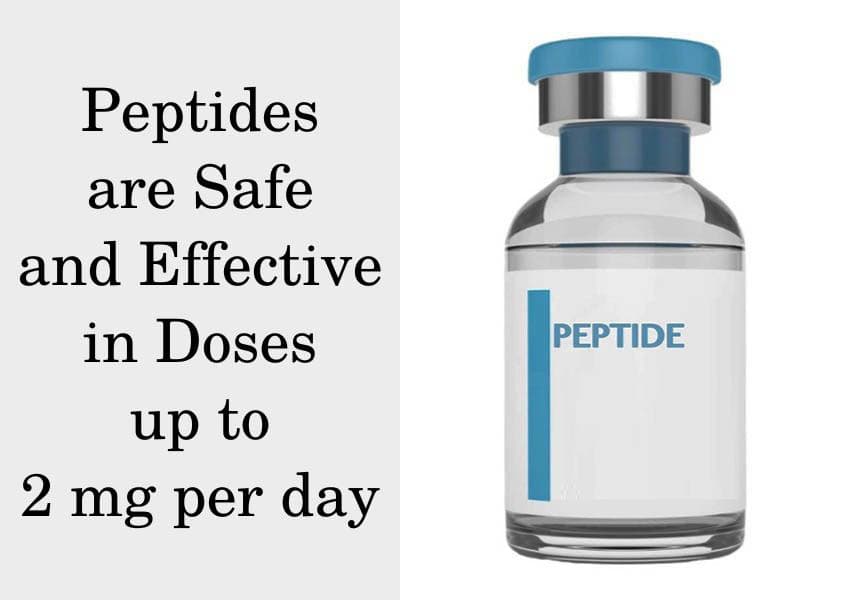
As a result, some peptide-based therapies can result in a significant increase in muscle growth and even overall weight gain.
For example, several peptides are known to upregulate the production of growth hormone (GH) and its main anabolic mediator, IGF-1, which is known to increase lean body mass.
The potential of peptides to stimulate muscle growth, albeit much lower than the effects of anabolic androgenic steroids (AAS), has also caused athletes and especially bodybuilders to experiment with different compounds.
We will break down the research on the most promising peptides for muscle growth and reveal more about their approval status, safety, and effectiveness,
How do peptides help build muscle?
Peptides may help build muscle by upregulating the production of anabolic hormones such as GH, and more specifically, the main mediator of its anabolic effects is insulin-like growth factor (IGF-1).
There are two main groups of peptides that can stimulate GH release, based on which receptors are activated:
- Growth hormone-releasing hormone (GHRH) analogs – peptides that activate the GHRH receptors in the pituitary gland and stimulate the release of GH. Notable examples include tesamorelin, sermorelin, and CJC-1295.
- Growth hormone secretagogues (GHSs) – peptides that activate the receptors of the hunger hormone ghrelin in various sites, including the pituitary gland, leading to the release of GH. In addition, GHSs also increase appetite and may affect other hormones. Notable GHSs are ibutamoren, ipamorelin, pralmorelin (GHRP-2), GHRP-6, and hexarelin.
GHRH analogs such as sermorelin have resulted in up to 2.78 lbs increase in lean mass within 16 weeks of therapy in older adults.
In comparison, the GHS ibutamoren (MK-677) caused a 6.6 lbs increase in lean mass without affecting fat mass after 8 weeks of therapy in a trial involving obese individuals.
It’s important to note that MK-677 possesses a modified non-peptide structure, but it has similar mechanisms of action and effects as the peptide-based compounds in the GHS class.
Some researchers have also stacked GHRH analogs with GHSs to potentially increase their effects on GH, IGF-1, and muscle growth. More specifically, sermorelin has been stacked with GHRP-2 and GHRP-6 in 14 men who were already on testosterone therapy.
The authors report that the combined therapy led to an increase in IGF-1 levels from 159.5 ng/ml on average to 263.8 ng/ml within the first 90 days. Yet, they do not report the specific effects of therapy on muscle and total body weight.
As noted, GHSs also increase appetite levels, which may lead to a significant increase in body weight in some individuals. Thus, patients may not gain only lean muscle but also some body fat when taking GHS.
Some studies have also reported that GHRH analogs such as sermorelin may influence other hormones, such as luteinizing hormone, which is a major regulator of testosterone production in men.
However, no direct effect of sermorelin or other GHRH/GHSs peptides on testosterone has been noted in clinical settings.
What are the best peptides for muscle growth?
The best peptides for muscle growth are the GHRH-mimetics and GHSs, which have been studied extensively in clinical settings or have already been approved for human use. Here are the most notable examples:
Sermorelin was FDA-approved for therapy in children with short stature and for diagnostic purposes in adults. Yet, the peptide was discontinued due to marketing reasons unrelated to its safety or effectiveness.
As mentioned, sermorelin has been shown to induce a significant increase in lean mass (+2.78 lbs) in healthy older men when administered for 16 weeks. It’s important to note that the study involved the lowest effective daily dose of 0.01mg per kg of body weight (0.8mg/day for 175 lbs person).
In addition, Sermorelin can be dosed at up to 2mg/daily in healthy men. Administering Sermorelin at higher doses and for longer periods may enhance its muscle-building properties, but research is currently lacking.
Tesamorelin is another GHRH analog that is approved by the FDA for human use. It is indicated for therapy in HIV/AIDS patients with lipodystrophy – a condition related to abnormal fat distribution, which commonly affects this subset of patients.
In addition to upregulating GH synthesis and improving fat distribution, tesamorelin at a dose of 2mg/daily has been reported to reduce muscle wasting in HIV/AIDS patients and induce significant improvement in muscle density and size within 26 weeks of therapy.
One of the few GHSs that has been studied in long-term clinical trials regarding its effect on lean mass is the aforementioned Ibutamoren, which can lead to a 6.6 lbs increase in lean mass. This peptide is typically administered orally thanks to its non-peptide structure in doses of 25mg daily.
How to use peptides safely for muscle growth
Peptides with potential for muscle growth, such as tesamorelin and sermorelin, are FDA-approved and considered safe for human use when taken in appropriate doses and under medical supervision.
Based on the available clinical data, these two peptides are safe and effective in doses of up to 2 mg per day. Both are typically administered as subcutaneous injections, taken once or twice daily.
Due to the suppressing effects of food on the release of growth hormone, it is recommended that sermorelin and tesamorelin are administered on an empty stomach, at least two hours after a meal.
Furthermore, they can be administered before bed, to mimic the natural release of GH more closely.
Apart from their intended indications, they can also be prescribed off-label, depending on your complaints and symptoms, as assessed by your medical doctor.
As shown by phase-3 trials, the most commonly reported side effects during tesamorelin therapy are:
- Injection site reactions – 24.5%
- Peripheral edema – 6.1%
- Worsened glycemic control (elevated glycated hemoglobin) – 4.5%
- Hypersensitivity reactions (local allergic reactions) – 3.6%
These side effects can be minimized or completely avoided by learning proper techniques for administration and undergoing close monitoring by experienced medical doctors.
Tesamorelin, sermorelin, and GHS are contraindicated in individuals with oncological diseases due to the known effect of GH on stimulating cell proliferation.
Are peptides better than steroids?
Peptides for muscle growth tend to have lower muscle-building potential but also potentially milder side effects when compared to high doses of testosterone and anabolic-androgenic steroids (AASs).
Studies in healthy men who were receiving AASs, including oxandrolone or testosterone esters, reveal that steroids can lead to 3.3 lbs – 13.2 lbs increase in lean mass across the trials.
This is considerably higher than the aforementioned 2.8 lbs – 6.6 lbs observed with peptides. Thus, steroids tend to have much more potent muscle-building effects than peptides.
However, this is not the only difference between the two classes of compounds. Here are other notable differences between peptides and steroids:
- Structure. Unlike the amino-acid structure of peptides, steroids are made of four fused carbon rings and various functional groups attached to them, this structure makes steroids fat-soluble.
- Mechanisms. Peptides for muscle growth work by upregulating the natural production of anabolic hormones. AASs mimic the function of the sex hormone testosterone (T) and other naturally occurring androgens (male hormones). Thus, they interact with the androgen receptors found in the nuclei of muscle cells and specifically upregulate muscle protein synthesis.
- Administration. AAS are usually administered as intramuscular injections. On the other hand, peptides are administered subcutaneously, which tends to be easier for the majority of patients.
- Timeline of effects. AAS can lead to a quick increase in muscle mass within 28 days even in patients on highly restrictive diets. On the other hand, peptide therapy may take 8-16 weeks before there are any significant results.
- Risk of side effects. As peptides induce an increase in GH levels that still remain within the reference range, they have a very low risk for side effects. On the other hand, AASs are usually used at supraphysiological doses and trigger a negative feedback loop in the hypothalamic-pituitary-gonadal (HPG) axis, which inevitably surpasses the physiological production of testosterone in the testes and causes infertility.
- Severity of adverse reactions. AASs activate the androgen receptors in a wide range of tissues, leading to potentially undesired effects such as oily skin, increased body hair, deeper voice, prostate hyperplasia, and others. In comparison, GHRH-analogs such as tesamorelin and sermorelin have great safety profiles and lead to only mild, transitory side effects such as water retention.



 Request Appointment
Request Appointment


